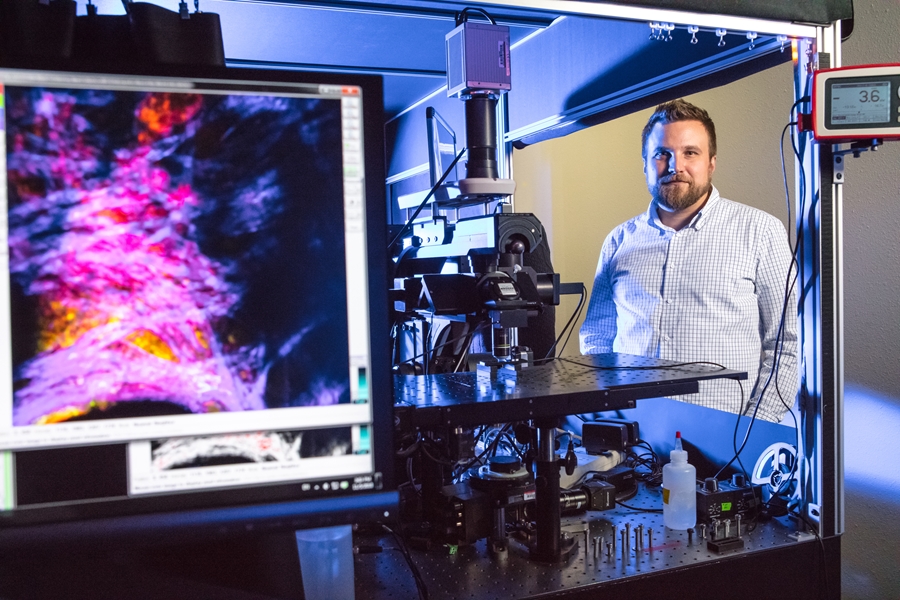
FAYETTEVILLE, Ark. – Researchers at the University of Arkansas have developed a new approach to diagnosing and monitoring chronic skin wounds, such as diabetic foot ulcers and pressure wounds.
Chronic skin wounds affect more than 150 million people worldwide and cost approximately $25 billion in health care annually in the United States alone. These non-healing wounds are characterized by inflamed tissue, poor blood circulation, callus formation or infection.
Current clinical approaches for diagnosing and monitoring these wounds do not provide critical diagnostic information about how they develop or why they do not heal.
Kyle Quinn, assistant professor of biomedical engineering, and Jake Jones, a doctoral student in biomedical engineering, have identified how cell metabolism changes over time during the healing process of wounds, by using a powerful imaging system capable of measuring changes in cellular metabolism.
Quinn and Jones used a process called label-free multiphoton microscopy to view tissue in three dimensions at the cellular level and generate 3D maps of wound metabolism. Label-free means the tissue was not artificially labeled with a fluorescent molecule. Multiphoton microscopy can facilitate measurements of naturally occuring cell and tissue autofluorescence, which is the emission of light by molecules naturally present in cells and tissue when those molecules have absorbed light.
In this study, autofluorescence imaging of two molecules – nicotinamide adenine dinucleotide (NADH) and flavin adenine dinucleotide (FAD) – were used to monitor cell metabolism. This was accomplished through a measurement called an optical redox ratio, which quantifies the relative concentrations of NADH and FAD. The researchers monitored wound metabolism in mice over a period of 10 days.

“To our knowledge, this is the first study showing changes in the optical redox ratio of tissue within live animals imaged through repeated sessions,” Quinn said. “We consider this a critical step in demonstrating the diagnostic potential of multiphoton microscopy for clinical wound care.”
Complications associated with diabetes are a common cause of chronic wounds. For this reason, Quinn and Jones’s study included diabetic mice, in addition to healthy, control mice.
The researchers observed differences between diabetic and control mice during the rebuilding of wound tissue. Changes in the optical redox ratio and NADH fluorescence among the diabetic mice indicated that cells remained at the wound edge, growing and dividing, rather than migrating over the wound to restore the skin’s protective barrier function.
“The ability of multiphoton microscopy to non-invasively collect structural and metabolic data suggests that it might have broader applications for wound care and dermatology,” said Quinn. “Providing quantitative metrics of cell function and wound composition has potential to supplement current standard of care and guide treatment options.”
Quinn’s research is supported by the National Institute on Aging and the National Institute of Biomedical Imaging and Bioengineering, both institutes of the National Institutes of Health. In 2015, he received a $745,000 Career Development Research Grant from the National Institute of Biomedical Imaging and Bioengineering to develop these imaging methods to better understand diabetic wounds. He received an additional $1.7 million grant from the National Institute on Aging in 2017 to continue his work with autofluorescence imaging methods to quantify and understand age-related delays in skin wound healing. His work is also supported by the Department of Defense and the Arkansas Biosciences Institute.
The study was published in Communications Biology.
About the College of Engineering: The University of Arkansas College of Engineering is the largest engineering program in the state of Arkansas. Over the past decade, the college has experienced unprecedented growth. Undergraduate enrollment has doubled since 2007, and total enrollment in the college is now over 4,000 students. The College of Engineering offers graduate and undergraduate degrees in nine engineering fields, as well as incorporating distance learning and interdisciplinary programs. Faculty in the college conduct research in many key areas, including electronics, energy, biomedical and healthcare engineering, materials science, transportation and logistics.
About the University of Arkansas: The University of Arkansas provides an internationally competitive education for undergraduate and graduate students in more than 200 academic programs. The university contributes new knowledge, economic development, basic and applied research, and creative activity while also providing service to academic and professional disciplines. The Carnegie Foundation classifies the University of Arkansas among only 2 percent of universities in America that have the highest level of research activity. U.S. News & World Report ranks the University of Arkansas among its top American public research universities. Founded in 1871, the University of Arkansas comprises 10 colleges and schools and maintains a low student-to-faculty ratio that promotes personal attention and close mentoring.
Topics
Contacts
Kyle Quinn, assistant professor of biomedical engineering
College of Engineering
479-575-5364, kpquinn@uark.edu
Matt McGowan, science and research communications officer
University Relations
479-575-4246,
dmcgowa@uark.edu